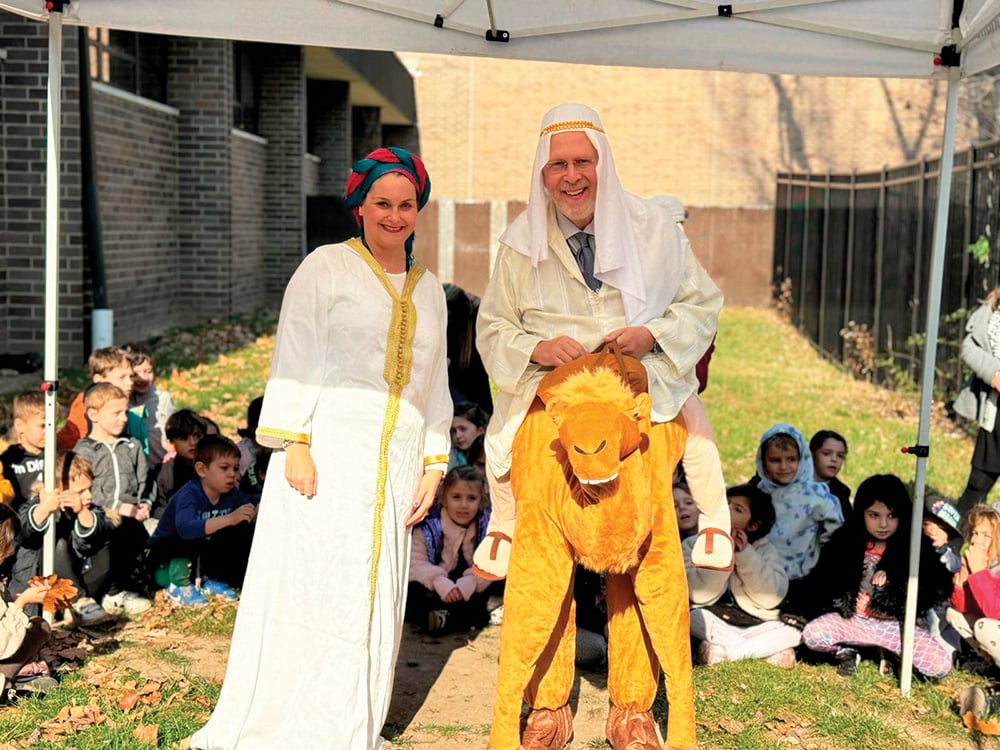Part I
From the destruction of the Second Commonwealth by the Romans in 70 CE until the establishment of the modern state of Israel in 1948, Palestine was neither a home for any other people, nor ever been considered a separate geopolitical entity, asserts historian Moshe Gil. When the Muslims invaded Palestine in 634, ending four centuries of conflict between Persia and Rome, they found direct descendants of Jews who had lived in the country since the time of Joshua bin Nun, who led the Jews into Canaan. For 2,000 years, Jews and Christians constituted the majority of the population, while the Bedouins were the ruling class.
Messianic Redemption:
The Centrality of the Land of Israel
Diaspora Jews, particularly believers in messianic redemption, returned to Palestine throughout the centuries, making aliyah (immigration to Israel) and settling the land, notes historian Arie Morgenstern.
Starting in the year 1240 (5000 on the Hebrew calendar), there was a mystical expectation at the beginning of each century that Jews could be redeemed if they returned to their land. Although these groups were never more than a small percentage of world Jewry, the fact that they involved leading Jewish figures from around the world had a profound effect on the majority of the Jews who remained behind.
The messianic impetus for aliyah and the centrality of the land of Israel, Morgenstern said, became a vital part of Jewish spiritual life. Although modern Zionism rejected the messianic tradition, it still embodied the belief in national redemption and the yearning for return to the land and even the reestablishment of sovereignty. The existence of the pre-modern Zionist aliyah movement from the 13th to the 19th centuries demonstrates that a number of Jews were not content only to pray for the return to Zion, but also saw aliyah as a realistic objective. In view of the difficulties of the journey, the uncertainty of finding employment and of being able to live in peaceful surroundings, it is understandable that more people did not go.
After 750, the Muslims Ruled Palestine
After 750, the Muslims ruled Palestine, Gil explains. Muhammad believed the day of judgment was near for the wicked of the world, and ordered the invasion of Palestine to spread the word of God to the righteous—the Muslims—who would soon inherit the entire world.
Aside from the 90 years during which the country was under the rule of Damascus, Palestine was far from a seat of power. The rulers in Damascus viewed it as part of Syria. Subsequent rulers in Baghdad and Egypt saw this neglected area as having only limited value, a source for tax revenue and some military functions.
Despite vast distances in reaching the country and other problems, Gil said, the Christians remained connected to Palestine, especially Jerusalem and their churches and monasteries. Their hold on the country steadily waned, apart from Jerusalem, where their members became further impoverished. On the eve of the first Crusades in 1095, the situation was quite desperate. Palestine continued to play a major role in only the lives of the Jews.
The Muslim conquest constituted a defining moment in the history of Jerusalem and of the Jewish population in the country. Jews returned to the city more than 500 years after expulsion (135-638) and established a Jewish quarter there. The Romans had forbidden them to enter Jerusalem, and killed any Jew caught trespassing. As a compromise between the demands of Jewish families and the restrictions imposed by the Christian patriarch, the Muslim authorities permitted 70 Jewish families to inhabit Jerusalem. Muslims and Jews cleaned up the Temple Mount, which had been used by the Romans as a garbage dump. A number of Jews were then appointed to keep the place clean.
The decision to allow Jews to return to Jerusalem is consistent with Muslim tradition that accepted the Jewish connection to the holy places, Gil pointed out. Jerusalem was considered the city of the Children of Israel, of the Prophets and of Kings David and Solomon. In a classic display of realpolitik, the Muslims sought a Jewish presence in Jerusalem in order to reduce Christian control of the city, which existed for 300 years.
The accounts of Bar-Sawma, a Christian monk, Gil notes, are a significant source of Palestine’s demographics in the Byzantine era. In his biography he wrote that the heathens and Jews comprised the majority in Palestine, Arabia and Phoenicia. Christians were still few in number. An anti-Jewish treatise written at the start of the Muslim invasion of Palestine suggests that there were large numbers of Jews in Acre and Haifa.
A comparatively large number of Jews also lived in Ramla after moving from Lod following the Muslim conquest. Arabic sources also refer to an accord reached by Muhammad in 630 with several Jewish settlements, indicating a considerable Jewish presence in southern Palestine. Arabic sources additionally describe the city of Eilat and its environs as having a large Jewish population.
In the northern part of the Arabian Peninsula, historian Bernard Lewis said, Medina was identified in Muslim sources as a Jewish city. Arab tribes eventually settled in the city, but were not involved in agricultural activities. Jews were known as exceptional farmers who cultivated the land on their plantations. During his final years, Muhammad forced Arab tribes, who were viewed as idolaters and heathens, living on the border of Palestine to adopt Islam and become part of a unified Islamic rule. Those who accepted Islam were permitted to keep their lands, and become “members of the Islamic ascendancy.” Those who refused were killed.
After establishing a new order, Gil indicates that Muhammad made a covenant with the Arab tribes, compelling every member of the clan to accept his authority, thus facilitating his ability to ultimately destroy the Jewish community of Medina. Some Jews were forbidden to remain in the city; others were killed. Jewish homes and land were confiscated and given to his impoverished followers, who had come from Mecca. Stolen Jewish property was also used to create a war chest to build a formidable military, which had never existed on the Arabian Peninsula.
In 628, the Muslims conquered the Khaybar region, approximately 150 miles north of Medina, another agricultural area in which Jews lived. Jews were forced to give the Muslims half of their annual date crop, and their palm trees became the property of the Muslim community. The Jews of Fadak and those living in Wadi’l-Qura (Valley of the Villages) on the border of Palestine suffered the same fate of becoming Muslim tenants.
Muhammad’s attitude toward the Jews Gil said, changed during the Tabuk campaign that lasted from mid-October to mid-December 630, as he encamped on the border of Palestine. Instead of taking their possessions and expelling them from their lands, he offered to protect the Jews and their property in return for special taxes to be determined in agreements, thus precluding the need for the Jews to maintain a military presence. These treaties became the legal basis within Islam for defining its relationship towards non-Muslims and became a key part of Islamic martial law.
By the summer of 634, most of the cities in Palestine were conquered. In a sermon on Christmas, the Jerusalem patriarch Sophronius described how the Arabs “plunder cities, despoil the fields, burn the villages, destroy holy monasteries.” Wary of attacks by the Muslim armies, Jerusalem Christians did not travel to Bethlehem to celebrate the holiday.
Falestin Is Not an Arabic Name
Once in power, Lewis said, the Arabs began renaming cities and places in Palestine. Some were given names in Arabic, but most were based on different pronunciations of the original names. Falestin, for example, which is not Arabic, is a distortion of Greek and Latin. The name is derived from the Philistines who lived on the coastal strip in biblical times. Epiphanius, who wrote about the Christian church in its early years and who died in May 402 explained, “The seed of Abraham is widespread in the land of Canaan, that is the Jewish land [Ioudaia] and in the land of the Philistines [Philistiaia], that which is now called Palaistine.”
Dr. Alex Grobman, a Hebrew University-trained historian, is senior resident scholar at the John C. Danforth Society and a member of the Council of Scholars for Peace in the Middle East.













